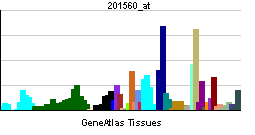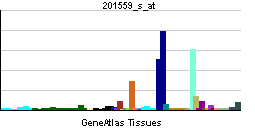CLIC4
| Chloride intracellular channel 4 | |||||||||||||
|---|---|---|---|---|---|---|---|---|---|---|---|---|---|
 PDB rendering based on 2ahe. | |||||||||||||
| |||||||||||||
| Identifiers | |||||||||||||
| Symbols | CLIC4 ; H1; CLIC4L; DKFZP566G223; FLJ38640; huH1; p64H1 | ||||||||||||
| External IDs | Template:OMIM5 Template:MGI HomoloGene: 8490 | ||||||||||||
| |||||||||||||
| RNA expression pattern | |||||||||||||
 | |||||||||||||
 | |||||||||||||
 | |||||||||||||
| More reference expression data | |||||||||||||
| Orthologs | |||||||||||||
| Template:GNF Ortholog box | |||||||||||||
| Species | Human | Mouse | |||||||||||
| Entrez | n/a | n/a | |||||||||||
| Ensembl | n/a | n/a | |||||||||||
| UniProt | n/a | n/a | |||||||||||
| RefSeq (mRNA) | n/a | n/a | |||||||||||
| RefSeq (protein) | n/a | n/a | |||||||||||
| Location (UCSC) | n/a | n/a | |||||||||||
| PubMed search | n/a | n/a | |||||||||||
Chloride intracellular channel 4, also known as CLIC4, is a human gene.[1]
Chloride channels are a diverse group of proteins that regulate fundamental cellular processes including stabilization of cell membrane potential, transepithelial transport, maintenance of intracellular pH, and regulation of cell volume. Chloride intracellular channel 4 (CLIC4) protein, encoded by the CLIC4 gene, is a member of the p64 family; the gene is expressed in many tissues and exhibits an intracellular vesicular pattern in Panc-1 cells (pancreatic cancer cells).[1]
References
Further reading
- Wick M, Bürger C, Brüsselbach S; et al. (1994). "Identification of serum-inducible genes: different patterns of gene regulation during G0-->S and G1-->S progression". J. Cell. Sci. 107 ( Pt 1): 227–39. PMID 8175911.
- Valenzuela SM, Martin DK, Por SB; et al. (1997). "Molecular cloning and expression of a chloride ion channel of cell nuclei". J. Biol. Chem. 272 (19): 12575–82. PMID 9139710.
- Duncan RR, Westwood PK, Boyd A, Ashley RH (1997). "Rat brain p64H1, expression of a new member of the p64 chloride channel protein family in endoplasmic reticulum". J. Biol. Chem. 272 (38): 23880–6. PMID 9295337.
- Qian Z, Okuhara D, Abe MK, Rosner MR (1999). "Molecular cloning and characterization of a mitogen-activated protein kinase-associated intracellular chloride channel". J. Biol. Chem. 274 (3): 1621–7. PMID 9880541.
- Edwards JC (1999). "A novel p64-related Cl- channel: subcellular distribution and nephron segment-specific expression". Am. J. Physiol. 276 (3 Pt 2): F398–408. PMID 10070163.
- Chuang JZ, Milner TA, Zhu M, Sung CH (1999). "A 29 kDa intracellular chloride channel p64H1 is associated with large dense-core vesicles in rat hippocampal neurons". J. Neurosci. 19 (8): 2919–28. PMID 10191309.
- Berryman M, Bretscher A (2000). "Identification of a novel member of the chloride intracellular channel gene family (CLIC5) that associates with the actin cytoskeleton of placental microvilli". Mol. Biol. Cell. 11 (5): 1509–21. PMID 10793131.
- Hartley JL, Temple GF, Brasch MA (2001). "DNA cloning using in vitro site-specific recombination". Genome Res. 10 (11): 1788–95. PMID 11076863.
- Wiemann S, Weil B, Wellenreuther R; et al. (2001). "Toward a catalog of human genes and proteins: sequencing and analysis of 500 novel complete protein coding human cDNAs". Genome Res. 11 (3): 422–35. doi:10.1101/gr.154701. PMID 11230166.
- Simpson JC, Wellenreuther R, Poustka A; et al. (2001). "Systematic subcellular localization of novel proteins identified by large-scale cDNA sequencing". EMBO Rep. 1 (3): 287–92. doi:10.1093/embo-reports/kvd058. PMID 11256614.
- Suginta W, Karoulias N, Aitken A, Ashley RH (2003). "Chloride intracellular channel protein CLIC4 (p64H1) binds directly to brain dynamin I in a complex containing actin, tubulin and 14-3-3 isoforms". Biochem. J. 359 (Pt 1): 55–64. PMID 11563969.
- Rønnov-Jessen L, Villadsen R, Edwards JC, Petersen OW (2002). "Differential expression of a chloride intracellular channel gene, CLIC4, in transforming growth factor-beta1-mediated conversion of fibroblasts to myofibroblasts". Am. J. Pathol. 161 (2): 471–80. PMID 12163372.
- Strausberg RL, Feingold EA, Grouse LH; et al. (2003). "Generation and initial analysis of more than 15,000 full-length human and mouse cDNA sequences". Proc. Natl. Acad. Sci. U.S.A. 99 (26): 16899–903. doi:10.1073/pnas.242603899. PMID 12477932.
- Berryman MA, Goldenring JR (2004). "CLIC4 is enriched at cell-cell junctions and colocalizes with AKAP350 at the centrosome and midbody of cultured mammalian cells". Cell Motil. Cytoskeleton. 56 (3): 159–72. doi:10.1002/cm.10141. PMID 14569596.
- Ota T, Suzuki Y, Nishikawa T; et al. (2004). "Complete sequencing and characterization of 21,243 full-length human cDNAs". Nat. Genet. 36 (1): 40–5. doi:10.1038/ng1285. PMID 14702039.
- Gerhard DS, Wagner L, Feingold EA; et al. (2004). "The status, quality, and expansion of the NIH full-length cDNA project: the Mammalian Gene Collection (MGC)". Genome Res. 14 (10B): 2121–7. doi:10.1101/gr.2596504. PMID 15489334.
- Wiemann S, Arlt D, Huber W; et al. (2004). "From ORFeome to biology: a functional genomics pipeline". Genome Res. 14 (10B): 2136–44. doi:10.1101/gr.2576704. PMID 15489336.
- Rual JF, Venkatesan K, Hao T; et al. (2005). "Towards a proteome-scale map of the human protein-protein interaction network". Nature. 437 (7062): 1173–8. doi:10.1038/nature04209. PMID 16189514.
- Bohman S, Matsumoto T, Suh K; et al. (2006). "Proteomic analysis of vascular endothelial growth factor-induced endothelial cell differentiation reveals a role for chloride intracellular channel 4 (CLIC4) in tubular morphogenesis". J. Biol. Chem. 280 (51): 42397–404. doi:10.1074/jbc. M506724200 Check
|doi=value (help). PMID 16239224. - Shiio Y, Suh KS, Lee H; et al. (2006). "Quantitative proteomic analysis of myc-induced apoptosis: a direct role for Myc induction of the mitochondrial chloride ion channel, mtCLIC/CLIC4". J. Biol. Chem. 281 (5): 2750–6. doi:10.1074/jbc. M509349200 Check
|doi=value (help). PMID 16316993.
| This protein-related article is a stub. You can help Wikipedia by expanding it. |